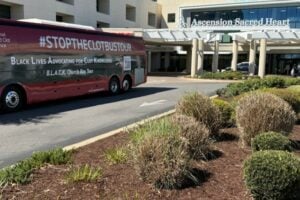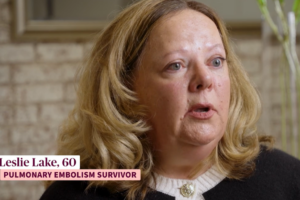What is factor V Leiden?
Individuals who have inherited one copy of the gene for factor V Leiden (heterozygotes) have a 3- to 10-fold increased risk of DVT or PE; individuals who have inherited two copies of the gene (homozygotes) have an 80- to 100-fold increased risk. Among individuals of northern European ancestry who appear to have inherited a tendency to form blood clots, 20 to 40 percent have been found to carry the factor V Leiden gene. Prior to the discovery of factor V Leiden, fewer than 10 percent of cases of thrombosis could be explained by an inherited thrombophilia.
The percentage of people who have factor V Leiden depends on the population studied. Higher percentages are reported among people of European ancestry compared to people from other continents. In the United States, factor V Leiden has been found in 5 percent of individuals of European ancestry, 2 percent of individuals of African ancestry, 2 percent of individuals of Hispanic ancestry, 2 percent of Native Americans, and less than 1 percent of individuals of Asian ancestry.
Lori’s story:
I remember the conversation as if it were yesterday. My mother shared with me the painful recollection of the loss of her son she delivered stillborn 14 months before she gave birth to me. We never talked about this sad experience again, not until 1999.
In June 1999, I was eight weeks pregnant and went to my obstetrician for my first pregnancy check-up. Before seeing the doctor, I filled out a family history form, noting that my younger brother had a blood clot in his arm, and my mother had pulmonary embolism— blood clots in the lungs. In addition, both my great aunt and her sister, who was my maternal grandmother, had blood clots in their legs. I discussed these medical findings with my doctor, and she ordered DNA testing to see if I had a genetic predisposition to clotting.
Two weeks passed, and I assumed that everything from my check-up was fine. I was wrong. My doctor called and said my DNA lab results showed that I am homozygous for a blood clotting condition called factor V Leiden. Having this disorder along with being pregnant put me at “high risk.” Without medication, I could develop clots, possibly resulting in a miscarriage or stillbirth. I immediately met with a hematologist and perinatalogist to discuss my disorder.
I learned that being homozygous, which means I inherited a defective gene from both my parents, puts me at an 80 to 100 times increased risk of having a blood clot. Since my doctors did not have a lot of experience with pregnant homozygous factor V Leiden patients, my case was presented during rounds at a local hospital for review and discussion. My medical management would include daily injections of low-molecular-weight heparin during my pregnancy and post delivery.
Initially, I was scared. I was concerned the heparin would harm the baby and me. There seemed to be a general lack of information about this disorder, and I felt isolated. My fear was further exacerbated when my mother developed pulmonary embolism during my pregnancy. Fortunately, she recovered and is now managed with Coumadin® therapy.
To learn more about factor V Leiden, I read my doctor’s notes, my lab tests, and articles on the Internet. I had faith in my doctors and my pregnancy went well. On January 17, 2000, my husband and I were blessed with the birth of our daughter.
Since discovering my disorder, I am enjoying life, and I try to make smart choices every day to decrease my risk of clotting. For example, I stay hydrated, I exercise, I am not on birth control pills, and I don’t smoke. In addition, [this experience] has allowed me to educate my extended family regarding its effects. My mother, father, brother, daughter, aunt, and cousins were tested and have factor V Leiden. Thanks to my experience, I feel empowered to educate people, particularly women, about thrombosis and thrombophilia. In August 2003, I co-founded the National Blood Clot Alliance (NBCA)
NBCA is a nationwide, community-based, voluntary health organization dedicated to preventing blood clots and ensuring that all persons suffering from blood clots and/or blood clotting disorders receive early diagnosis, optimal treatment, and quality support. NBCA sustains its mission through research, education, support, and advocacy on behalf of those at risk of, or affected by, blood clots and blood clotting disorders. NBCA’S Web site is www.NBCAinfo.org
Not only has NBCA grown, but my daughter is now 6½ years old. She understands that she has a blood clotting disorder, which she calls “sticky blood.” My mother is still on Coumadin® and doing well, and my cousin took heparin during her pregnancies and now has two healthy little boys. I am currently six months pregnant and taking low-molecular-weight heparin again. I have a great team of physicians. A perinatalogist and a hematologist manage my case together to ensure I am in good health.
Overall, I am very grateful my genetic disorder was identified. The death of my grandmother from a stroke, most likely the result of a clot, and the future of my family spur me on to increase awareness, research, and treatment of blood clots and blood clotting disorders. My grandmother may have had an undiagnosed clotting disorder. She died approximately 20 years before a genetic test was available. Knowledge is power. It can save lives. If nothing else, I want my children to accept having a blood clotting disorder, not to fear it.
Lori Preston, MBA
Vice President and co-founder of NBCA























